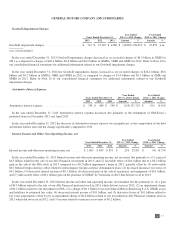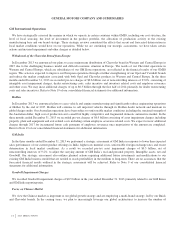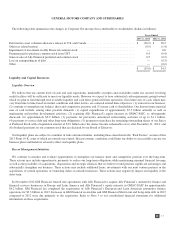General Motors 2013 Annual Report Download - page 34
Download and view the complete annual report
Please find page 34 of the 2013 General Motors annual report below. You can navigate through the pages in the report by either clicking on the pages listed below, or by using the keyword search tool below to find specific information within the annual report.
GENERAL MOTORS COMPANY AND SUBSIDIARIES
In the year ended December 31, 2012 Total net sales and revenue increased due primarily to: (1) increased wholesale volume of
41,000 vehicles (of 4.0%) due primarily to strong industry growth across the region; coupled with an increase from the consolidation
of GM India effective September 2012 resulting in an inclusion of 29,000 wholesale vehicle sales (or 2.8%); (2) favorable pricing due
to higher pricing on new models launched; and (3) favorable vehicle mix due to increased export of new product; partially offset by
(4) Other of $0.6 billion due primarily to unfavorable net foreign currency effect due to the weakening of the Korean Won and South
Africa Rand against the U.S. Dollar of $0.5 billion; and decrease in components, parts and accessories revenue of $0.1 billion.
GMIO EBIT-Adjusted
In the year ended December 31, 2013 EBIT-adjusted decreased due primarily to: (1) unfavorable net vehicle mix primarily in
Middle East and Australian markets; (2) unfavorable pricing excluding $0.2 billion sales incentive related to withdrawal of the
Chevrolet brand from Europe; (3) unfavorable net wholesale volumes; and (4) Other of $0.2 billion due primarily to unfavorable
manufacturing costs of $0.3 billion; unfavorable net foreign currency effect of $0.2 billion; and a decrease in sales of components,
parts and accessories of $0.2 billion; partially offset by favorable material and freight cost of $0.3 billion; and increased equity
income, net of tax of $0.2 billion, from our interest in the increased net income of our China JVs.
In the year ended December 31, 2012 EBIT-adjusted increased due primarily to: (1) favorable pricing due to higher pricing on new
models launched; and (2) favorable net wholesale volumes; partially offset by (3) unfavorable net vehicle mix; and (4) Other of $0.9
billion due primarily to increased costs of $1.0 billion due primarily to increased material, freight and manufacturing costs; partially
offset by net gain of $0.1 billion measured as the difference between the fair value of our 50% interest in GM India and the
investment carrying amount at the date of acquisition.
GM South America
Venezuelan Operations
Our Venezuelan subsidiaries functional currency is the U.S. Dollar because of the hyperinflationary status of the Venezuelan
economy.
Effective February 13, 2013 the Venezuelan government set the official fixed exchange rate of the Bolivar Fuerte (BsF) at BsF 6.3
to $1.00 from BsF 4.3 to $1.00. The devaluation resulted in a charge of $0.2 billion in the three months ended March 31, 2013 from
the remeasurement of our Venezuelan subsidiaries’ non-U.S. Dollar denominated monetary assets and liabilities. We believe it is
possible that the Venezuelan government may further devalue the BsF against the U.S. Dollar in the future. If the BsF were devalued
further, it would result in a charge to our income statement in the period of devaluation. Based on our December 31, 2013 net
monetary assets, a charge of approximately $0.1 billion would result for every 10% devaluation of the BsF.
In December 2013 a new decree became effective requiring the government of Venezuela to set prices for all vehicles, parts and
accessories sold in the country. In addition the Venezuelan government has foreign exchange control regulations that make it difficult
to convert BsF to U.S. Dollars which affect our Venezuelan subsidiaries’ ability to pay non-BsF denominated obligations and to pay
dividends. In January 2014 the Venezuelan government announced changes to the foreign exchange process which could affect the
rate at which our Venezuelan subsidiaries buy dollars. These regulations, when considered with other governmental policies
impacting labor force reductions and other circumstances in Venezuela, may limit our ability to fully benefit from and maintain our
controlling financial interest in our Venezuelan subsidiaries. The financial impact on our operations in Venezuela of these events and
associated ongoing restrictions are uncertain.
The total amounts pending government approval for settlement in U.S. Dollar at December 31, 2013 and 2012 were BsF 3.7 billion
(equivalent to $0.6 billion) and BsF 2.2 billion (equivalent to $0.5 billion). These amounts include requests in the amount of BsF 0.6
billion (equivalent to $0.1 billion) that have been pending from 2007. Our Venezuelan subsidiaries net assets were $0.9 billion at
December 31, 2013, including net monetary assets of $1.0 billion. At December 31, 2013 other consolidated entities had receivables
from our Venezuelan subsidiaries denominated in other currencies of $0.5 billion.
32
2013 ANNUAL REPORT
























